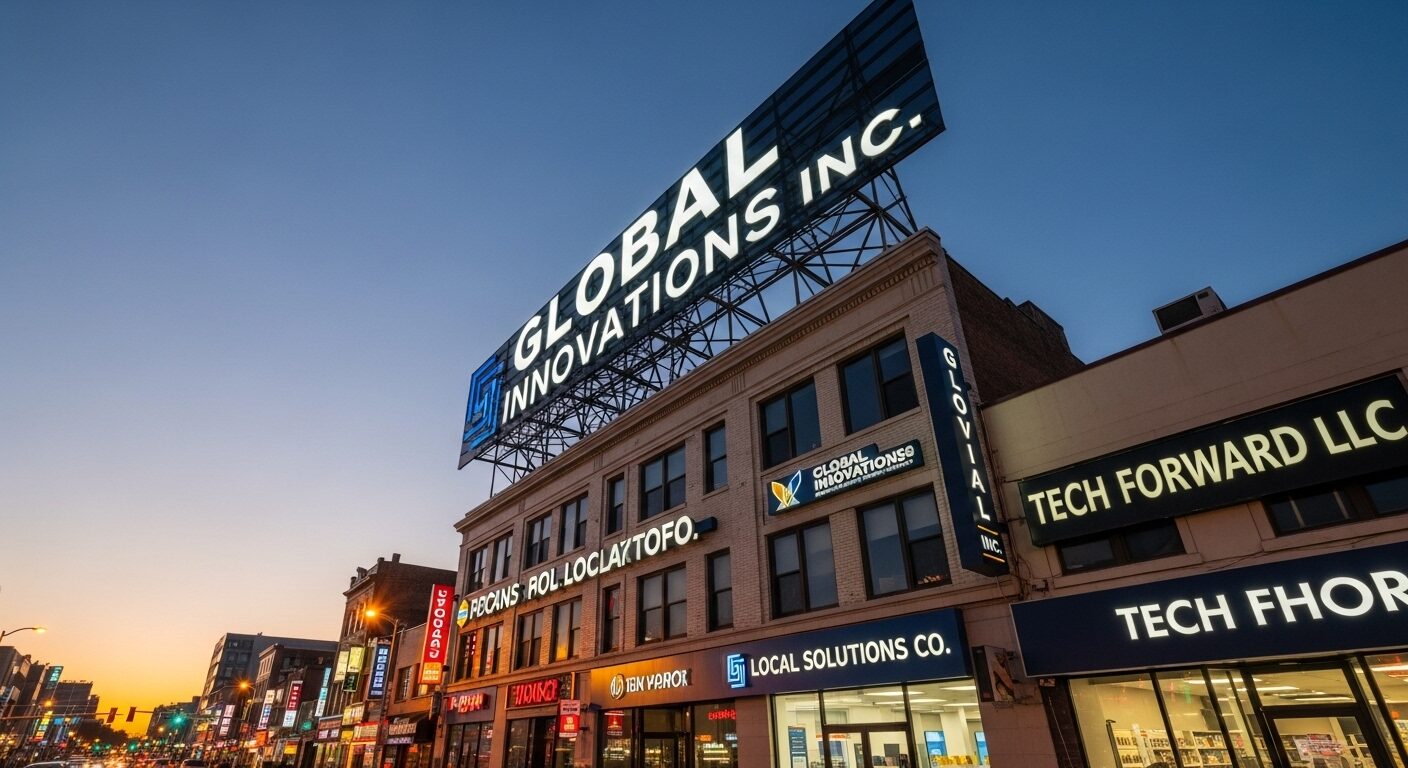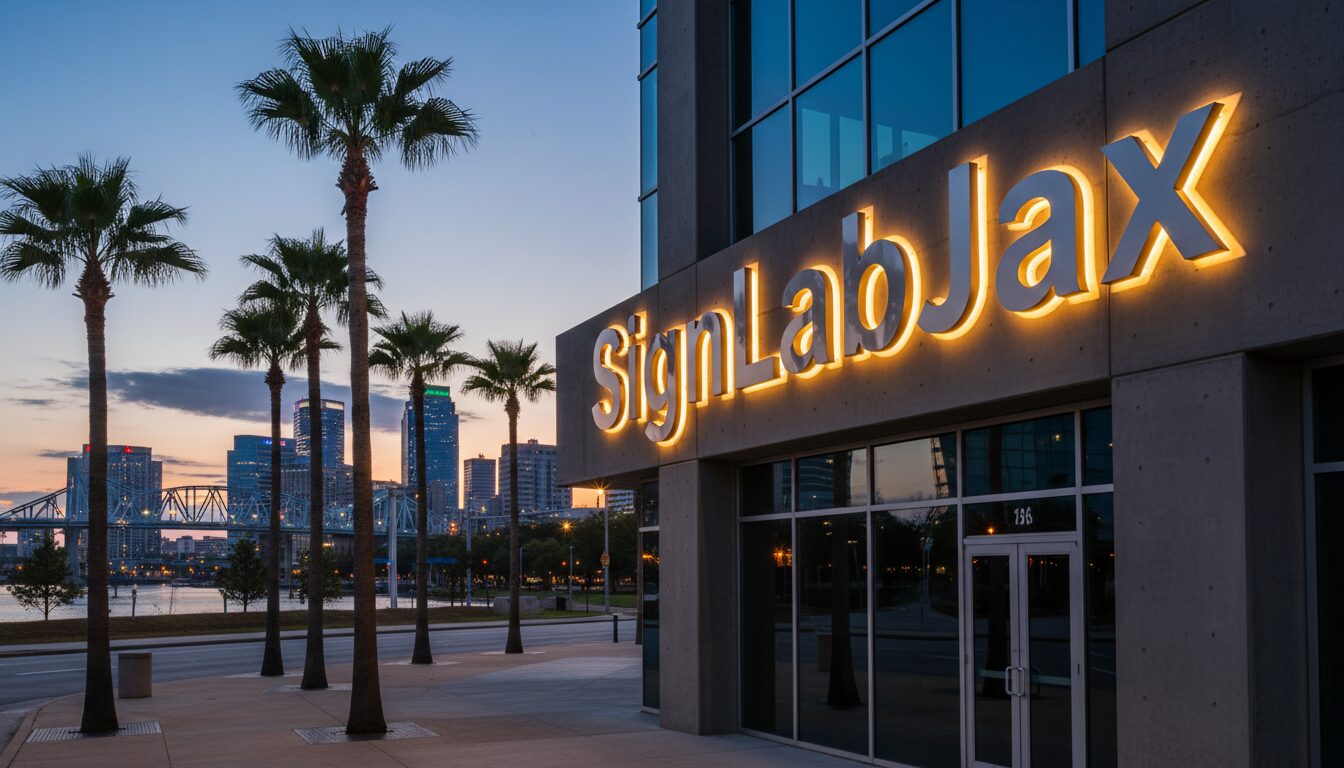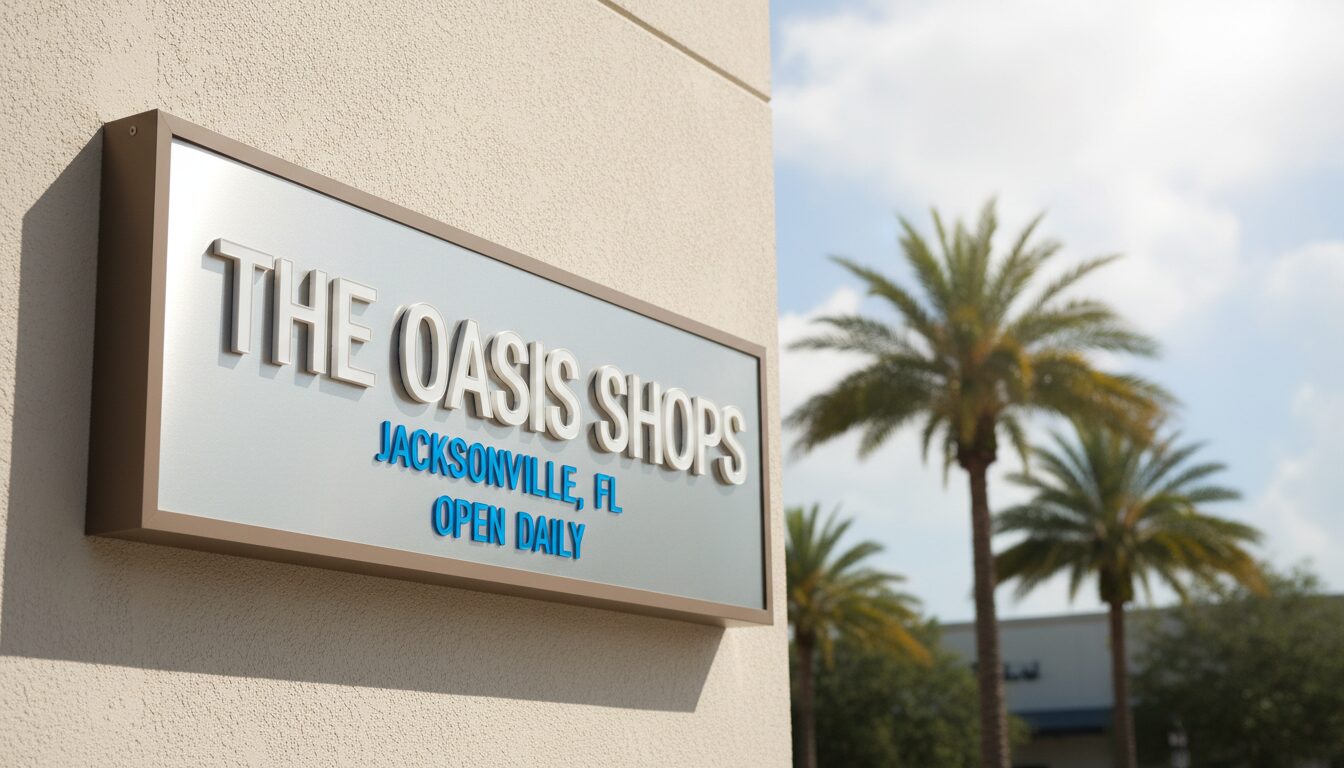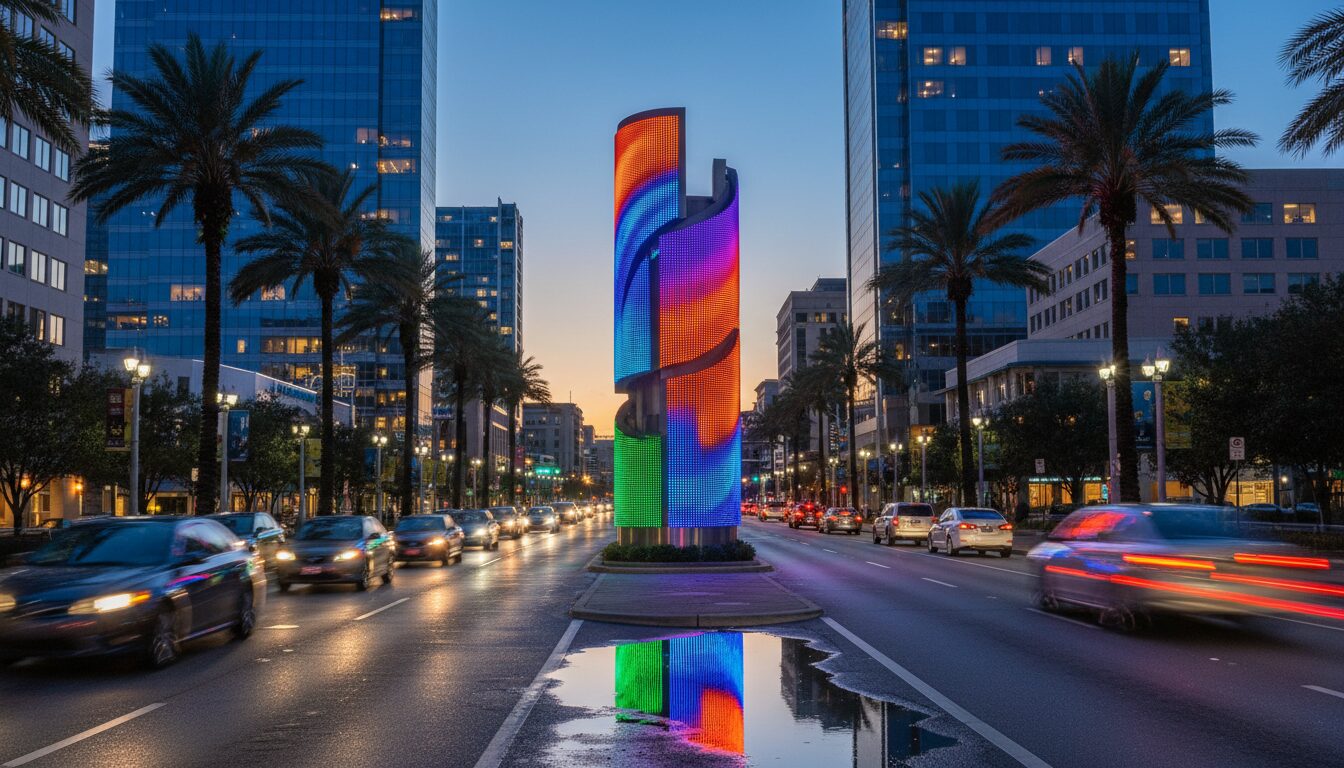Exterior signage does more than identify your business location – it establishes territorial presence that communicates market leadership and community authority to everyone who passes by. In local markets, the most recognizable and strategically positioned exterior signs create psychological associations with market dominance that influence customer choice and competitive positioning.
This territorial aspect of exterior signage operates on subconscious levels, with prominent, well-designed signs creating impressions of business stability, market leadership, and community integration that extend far beyond simple brand recognition. Customers often associate the most visible businesses with market leadership, quality, and reliability, making exterior signage a critical tool for establishing local brand authority.
Understanding how exterior signs build local brand authority enables businesses to make strategic decisions about design, placement, and messaging that reinforce market leadership while creating competitive advantages that are difficult for newcomers to overcome.
Territorial Psychology and Market Presence
Exterior signage functions as territorial markers that communicate business ownership of commercial space while establishing psychological boundaries that influence customer perception of market hierarchy and competitive positioning within local business ecosystems.
Visual Territory Establishment occurs when businesses use prominent exterior signage to claim visual dominance within their commercial environment. The most visible and memorable signs create mental associations with market leadership that customers use to evaluate relative business importance and stability.
Prominent placement, superior design quality, and consistent visibility create impressions that the business “owns” its market space in ways that newer or less visible competitors cannot easily challenge. This visual ownership translates into customer assumptions about business success, longevity, and market position.
Psychological Market Hierarchy develops as customers subconsciously rank businesses based on visual prominence and signage quality within their local area. The businesses with the most impressive and visible exterior signs often become mental shortcuts for quality and reliability in their market category.
This hierarchy influences customer decision-making during both routine purchases and important buying decisions, with customers often choosing the most visible and established-appearing businesses when quality differences are unclear or decision time is limited.
Community Integration Signals emerge through exterior signage that demonstrates long-term commitment to local presence and community involvement. Signs that appear permanent, well-maintained, and architecturally integrated suggest businesses invested in long-term community relationships rather than temporary market participation.
These integration signals build customer confidence in business stability while creating competitive barriers for businesses that appear temporary or uncommitted to local market presence through inferior or obviously temporary signage solutions.
Strategic Placement for Authority Building
Location and positioning of exterior signage significantly influence its effectiveness in establishing local brand authority, with strategic placement decisions determining how effectively signage communicates market leadership and competitive positioning within the local business environment.
High-Traffic Visibility Points maximize exposure to potential customers while demonstrating business confidence and market investment. Securing prominent signage locations often requires significant investment that smaller or newer competitors cannot match, creating natural barriers to competitive visibility.
Corner locations, main thoroughfare frontage, and elevated positioning create maximum exposure while suggesting business success and market position that attracts customers who associate visibility with quality and reliability.
Architectural Integration Excellence demonstrates long-term commitment and substantial investment that temporary or uncertain businesses cannot justify. Signage that appears to be part of the original architectural plan suggests established businesses with permanent local presence.
Custom architectural signage often requires building modifications or specialized installation that represents significant investment in local presence, creating visual evidence of business commitment that influences customer perception of stability and market position.
Multi-Location Coordination amplifies local authority through consistent brand presence across multiple visible locations. Businesses that maintain high-quality signage at multiple local locations create impressions of market dominance and substantial local investment.
Coordinated signage programs across multiple locations demonstrate organizational sophistication and market investment that smaller competitors cannot easily replicate, reinforcing perceptions of market leadership and business success.
Strategic Competitive Positioning involves signage placement that creates favorable comparisons with competitors while maximizing differentiation advantages. Positioning superior signage near competitor locations can highlight quality differences that influence customer choice.
Design Elements That Communicate Authority
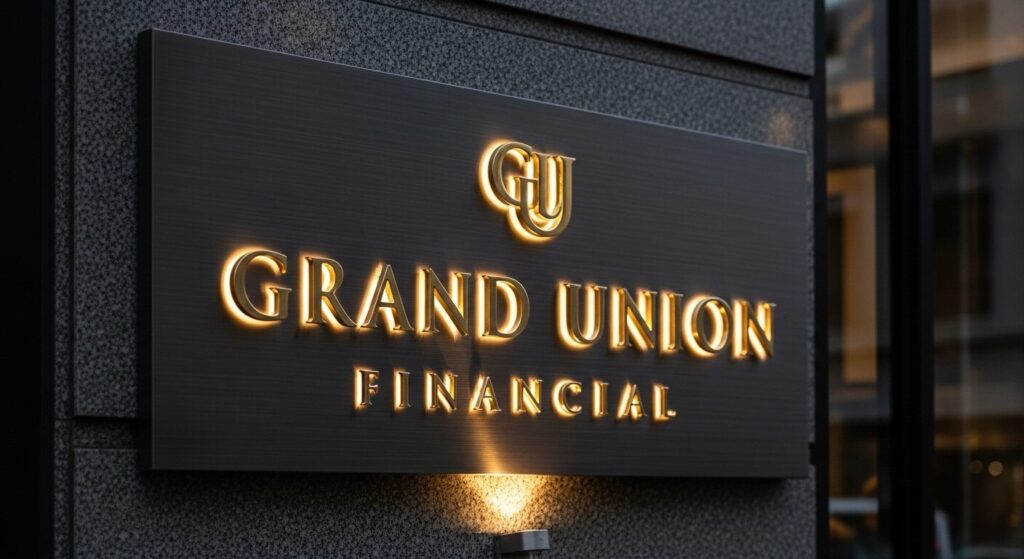
Specific design characteristics within exterior signage communicate different levels of market authority and business establishment, with certain visual elements consistently creating stronger impressions of leadership and competitive advantage than others.
Scale and Proportional Impact create immediate impressions of business importance and market position. Appropriately scaled signage that commands attention without appearing excessive suggests businesses with confidence in their market position and customer value proposition.
Undersized signage can suggest budget constraints or lack of market confidence, while oversized signage may appear aggressive or compensatory. The optimal scale demonstrates market confidence while respecting community standards and architectural context.
Material Quality and Permanence communicate business investment in long-term local presence while creating visual evidence of success and stability. Premium materials suggest businesses with sufficient success to invest in quality presentation and long-term market commitment.
Temporary or obviously inexpensive materials can undermine authority by suggesting budget constraints, uncertain market position, or temporary business presence that customers may interpret as risk factors for service continuity or business reliability.
Professional Design Sophistication demonstrates business maturity and market expertise through visual communication that reflects strategic thinking and brand management competence. Sophisticated design suggests businesses with professional marketing knowledge and sufficient resources for strategic brand development.
Amateur or outdated design can suggest businesses that lack marketing sophistication or adequate resources for professional presentation, potentially undermining customer confidence in business competence and market position.
Lighting and Visibility Technology extends authority establishment into evening hours while demonstrating business investment in customer accessibility and market presence. Professional lighting suggests businesses committed to serving customers during extended hours while maintaining professional appearance standards.
Brand Consistency Integration reinforces authority through demonstrating professional brand management across all customer touchpoints. Consistent exterior signage that aligns with other brand elements suggests businesses with strategic marketing approach and professional brand management capabilities.
Community Perception and Local Leadership
Exterior signage influences how community members perceive businesses as local leaders, contributing members, or temporary participants in the local economic ecosystem, with these perceptions affecting customer loyalty and word-of-mouth recommendations.
Civic Integration Appearance develops when exterior signage appears to enhance rather than detract from local architectural character and community aesthetics. Signs that complement local character while maintaining distinctive brand identity suggest businesses that respect community values while contributing positively to local environment.
This civic integration creates positive community sentiment that translates into customer loyalty and word-of-mouth recommendations that are particularly valuable in local markets where community opinion significantly influences business success.
Stability and Permanence Signals emerge through signage design and installation quality that suggests long-term local commitment rather than temporary market participation. Signs that appear designed for longevity create community confidence in business permanence and ongoing local contribution.
Permanent-appearing signage encourages customer investment in ongoing relationships while reducing concerns about business continuity that might discourage customers from choosing newer or apparently temporary businesses.
Local Culture Respect demonstrates through signage design choices that acknowledge local preferences, architectural traditions, or community values while maintaining distinctive brand identity. This balance suggests businesses that understand and respect local market characteristics.
Cultural sensitivity in signage design builds community acceptance while avoiding conflicts that might create negative community sentiment or regulatory challenges that could undermine market position.
Economic Contribution Visibility appears through signage quality and scale that suggests significant local economic investment and job creation. Substantial signage investments create impressions of businesses that contribute meaningfully to local economic activity.
These contribution signals build community support while creating competitive advantages through positive local relationships that newer or less invested competitors cannot easily replicate.
Competitive Differentiation Through Exterior Presence
Strategic exterior signage creates competitive advantages by establishing visual differentiation that influences customer choice while creating barriers that competitors must overcome to achieve similar market presence and authority.
Visual Market Ownership occurs when superior exterior signage creates customer associations between the business and market category leadership. The most visible and memorable signs often become mental shortcuts for entire product or service categories within local markets.
This market ownership makes it difficult for competitors to achieve similar customer recognition and market position without significant investment in competing signage that may still struggle to overcome established visual associations.
Quality Standard Setting happens when premium exterior signage establishes visual benchmarks that competitors must meet or exceed to appear credible within the market. High-quality signage forces competitors to invest significantly in visual presentation to avoid appearing inferior.
Professional Standard Demonstration through sophisticated signage design and installation creates expectations that customers apply to all businesses in the category. Businesses with superior exterior signage often force competitors to upgrade their visual presentation to remain competitive.
Innovation Leadership Communication emerges through signage that incorporates advanced technologies or design approaches that suggest businesses at the forefront of industry development. Innovative signage can position businesses as market leaders rather than followers.
Early adoption of new signage technologies or design trends can create competitive advantages by establishing businesses as innovative leaders that customers associate with advanced expertise and forward-thinking approaches.
Long-Term Authority Building Strategies
Building sustainable local brand authority through exterior signage requires strategic thinking that extends beyond immediate visibility to create lasting competitive advantages and community relationships that compound over time.
Investment Progression Planning involves developing signage strategies that allow for strategic upgrades and expansions that reinforce growing market authority while accommodating business growth and changing market conditions.
Planned upgrade paths enable businesses to demonstrate continued growth and market success through progressive signage improvements that maintain competitive advantages while suggesting ongoing business development and market expansion.
Community Relationship Development through signage choices that demonstrate ongoing commitment to local community while building positive relationships with local officials, community leaders, and neighboring businesses.
Positive community relationships can provide competitive advantages through preferential treatment in permitting, community support during challenges, and word-of-mouth recommendations that are particularly valuable in local markets.
Market Evolution Adaptation enables businesses to maintain authority as local markets change through signage strategies that accommodate new competitors, changing customer preferences, or evolving community standards.
Flexible signage strategies prevent businesses from appearing outdated or rigid while maintaining core authority elements that preserve competitive advantages and market leadership position.
Measuring Local Authority Impact
Evaluating the effectiveness of exterior signage in building local brand authority requires assessment methods that capture both quantitative business impacts and qualitative community perception changes that indicate growing market position.
Community Recognition Tracking through monitoring mentions in local media, community discussions, and customer feedback that indicate growing recognition as local market leaders or community contributors.
Customer Acquisition Analysis helps determine whether exterior signage successfully attracts new customers while building recognition that translates into business growth and market share expansion.
Competitive Position Assessment evaluates how exterior signage affects competitive dynamics and whether signage investments create sustainable advantages that are difficult for competitors to overcome.
Local Partnership Opportunities often increase as businesses establish greater community authority through professional exterior signage that builds credibility with other local business leaders and community organizations.
Frequently Asked Questions About Exterior Signs and Local Authority
How long does it take for exterior signage to establish local brand authority?
Local authority development typically occurs gradually over months and years as community members become familiar with consistent, high-quality exterior signage. Initial impact may be noticeable within weeks, but substantial authority building usually requires sustained visibility over multiple seasons and business cycles.
Can small businesses compete with larger companies through strategic exterior signage?
Yes, strategic exterior signage can help smaller businesses establish local authority that competes effectively against larger companies with greater resources. Superior design, better placement, or stronger community integration can create competitive advantages that overcome size disadvantages.
How important is signage consistency across multiple business locations?
For multi-location businesses, consistency reinforces authority by demonstrating organizational sophistication and brand management competence. Consistent high-quality signage across locations creates impressions of business success and market dominance that individual locations cannot achieve independently.
What role do local regulations play in authority-building signage strategies?
Local regulations can limit signage options but also create opportunities for businesses willing to invest in compliance with higher standards. Understanding and exceeding regulatory requirements can create competitive advantages while building positive relationships with local officials.
How do businesses balance brand differentiation with community integration?
Successful authority-building signage maintains distinctive brand identity while respecting local architectural character and community preferences. This balance requires understanding local market characteristics while preserving brand elements that create recognition and differentiation.
Can exterior signage authority transfer to other marketing channels?
Yes, local authority established through exterior signage often enhances effectiveness of other marketing efforts by reinforcing credibility and market position across all customer touchpoints. Strong local presence creates positive bias that improves response to advertising, social media, and other marketing activities.
Building Sustainable Local Market Authority
Exterior signage represents one of the most powerful tools for establishing local brand authority, but success requires strategic thinking that extends beyond immediate visibility to create lasting competitive advantages and community relationships.
The most effective authority-building signage strategies align visual presentation with business capabilities while demonstrating genuine commitment to local market success and community contribution. This alignment creates sustainable competitive advantages that are difficult for competitors to replicate or overcome.
Understanding the psychological and social dynamics of local authority development enables businesses to make signage investments that build long-term competitive advantages while strengthening community relationships that support sustainable business growth.
Ready to establish local brand authority through strategic exterior signage? Contact SignLab JAX today to discuss how professional exterior signage can position your business as the recognized leader in your local market while building the community authority that drives long-term success.

